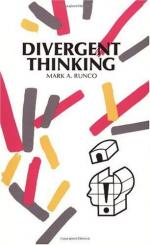|
This section contains 633 words (approx. 3 pages at 300 words per page) |

|
The ability to come up with original and unique ideas and to envision multiple solutions to a problem.
The concept of divergent thinking was developed in the 1950s by psychologist J. P. Guilford, who saw it as a major component of creativity and associated it with four main characteristics: fluency (the ability to rapidly produce a large number of ideas or solutions to a problem); flexibility (the capacity to consider a variety of approaches to a problem simultaneously); originality (the tendency to produce ideas different from those of most other people); and elaboration (the ability to think through the details of an idea and carry it out). Guilford, whose research was oriented toward testing and measurement (psychometrics), believed that creative thinkers are at a disadvantage when taking standard intelligence tests, which penalize divergent thinking and reward its opposite, convergent thinking—the ability to narrow all possible...
|
This section contains 633 words (approx. 3 pages at 300 words per page) |

|


